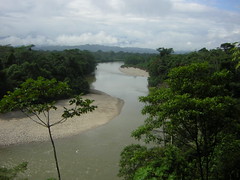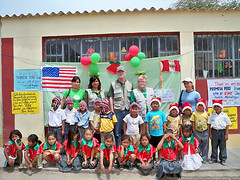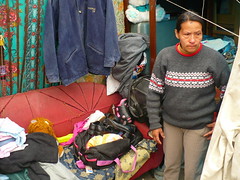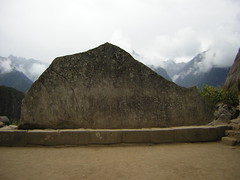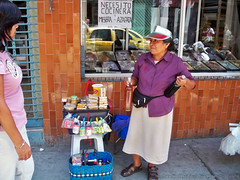ITN News reports on the yearly tradition of the pisco fountain in the Plaza de Armas. It has long since become a popular part of the Fiestas Patrias celebrations. (Previous year’s)
Category: "Life"
Lima and Callao in Black and White
A collection of my photos of the city of Lima in black and white.
Across from Ollantaytambo
When I first visited the ruins of Ollantaytambo, I saw the Inca store houses up on the other side of the valley across the town. There’s no way I could have climbed up there back then, I was just too exhausted. I figured I’d visit them “next time”, whenever that would be. A couple of years passed, and “next time” finally came.
Barbara ends up doing the Whipping Dance [Featured]
Expat writer Barbara Drake describes how she got pulled into doing the “Whipping Dance” at 15,000 feet above sea level.
Peru’s reading culture
Bill Cochran, reader, librarian, Gutenberger and Twitter user, wondered what my take on reading, library and book culture in Peru was. I personally am an avid reader. I like reading factual texts, not entire texts, but just the parts that catch my interest before I spot another theme or topic of that launches me into another book – perhaps halfway through another book. I can while away hours like this, loosing track of time – my feeble product-of-its-time miniute concentration span and my constant hopping about never allowing me to become bored. Like probably a growing number of others, I don’t read much fiction for entertainment, preferring to have my imagination done for me in the form of TV. But at least I read.
What I am getting at is that I might not be as knowledgeable in this subject as I could be, and my opinion below about Peruvians is just my opinion. It may be incorrect, perhaps I have been meeting all the wrong people. If you are Peruvian or have lived here, I would ask you to please leave your comment at the end of this post and tell us what your experience is.
Do Peruvians read? No.
Unlocking the secrets of the Quipus
Gary Urton. The investigator from Harvard University reveals the latest results of his investigations of the meaning of the quipu.
As I explained in this previous post, the quipu (or khipu) is a fascinating communication device used in the pre-Columbian world for everything from accounting and record keeping to, it is believed, recording detailed text… names, words, a full written language not in symbols but in lengths of string and knots tied at points along them.
The changing face of Cusco’s plaza
From sacred imperial capital of the Incas to commercial centre home to American chains like McDonald’s and Starbucks, the face of Cusco is changing with the times.
Cementerio Barquíjano
Walking along Av. Oscar R. Benavides, once called the Avenida Colonial that joined Callao with distant Lima, I happened upon this very pretty cemetery. It was Sunday and the large entrance was busy with families visiting lost relatives and flower sellers doing a brisk trade.
This public cemetery, built in 1859 is the final resting place of Chalacos (as the people from Callao are called) both rich and poor. The rich have built grand mausoleums while the poor suffice with a nook in a wall of tombs. Interestingly for such an old cemetery it is still in use, and it is a strange contrast to see much more modern mausoleums and graves alongside much older ones, or see old family plots more recently added to. It is also obvious, through the placing of fresh flowers and candles, whom among the dead are still remembered and mourned, and who have been forgotten.
Keiko Fujimori battles evidence of her father’s corruption
Keiko Fujimori, daughter of the corrupt ex-dictator Alberto Fujimori who was recently sentenced for human rights abuses during the country’s fight against Maoist terrorists, is having a hard time battling the slow release of facts relating to her father’s regime.
Dignity of a Nation [Featured]
Three professional advocates journey from Ohio to Peru, South America to experience and assess basic needs of a community outside of capital city, Lima. The journey follows them as they risk infection, danger, and communication barriers while engaging in global empowerment for change. They discover and pinpoint the basic needs of the community while befriending a high school drop-out and graffiti artist.
The first Peruvian car
Such is Peruvian ingenuity that this was the first nation in South America to produce high-quality automobiles. World-beating ones at that. But as great as Peruvian creativity… is a lack Peruvian self esteem. What could have been the start of a major Peruvian industry was snuffed out by Peruvians themselves, who then, as now, see everything from abroad as better, whether it really is or not.
Barin Bababo: Shipibo Konibo: Cosmovision of an Amazonian People [Featured]
I wrote a short time ago about the Shipibo people, an indigenous Amazonian tribe, some of whom now live on the polluted river Rímac in Lima’s desert. (Alejandro also introduced us to the River Rimac Project)
Here, Alejandro tells us more about the Shipibo people living in Rimac, and their fascinating artwork.




